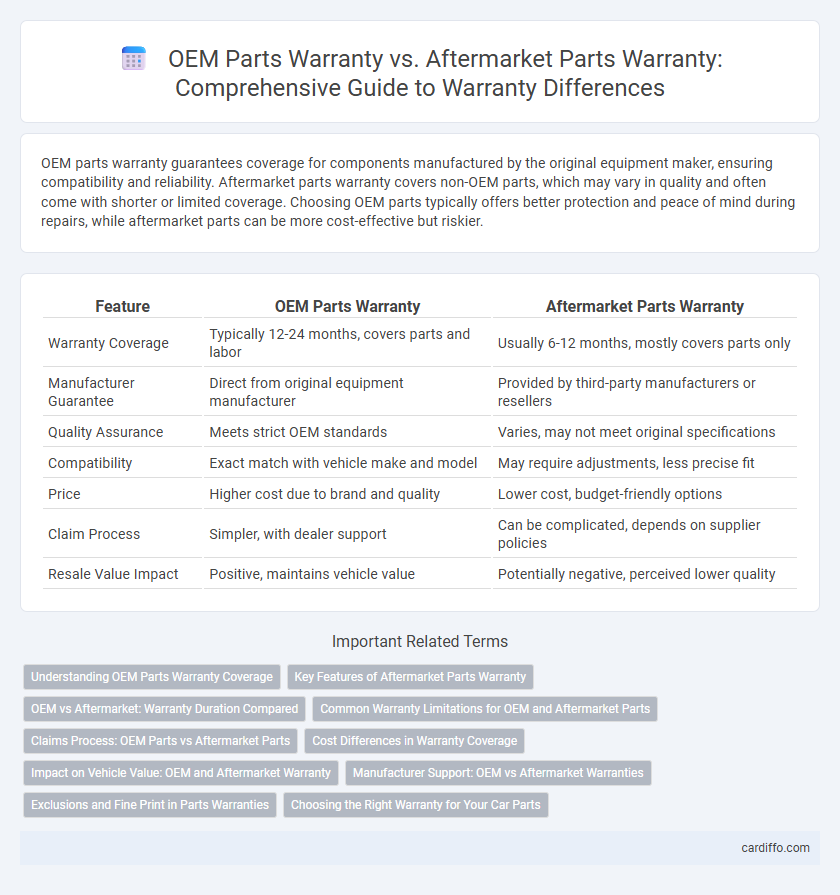OEM parts warranty guarantees coverage for components manufactured by the original equipment maker, ensuring compatibility and reliability. Aftermarket parts warranty covers non-OEM parts, which may vary in quality and often come with shorter or limited coverage. Choosing OEM parts typically offers better protection and peace of mind during repairs, while aftermarket parts can be more cost-effective but riskier.
Table of Comparison
| Feature | OEM Parts Warranty | Aftermarket Parts Warranty |
|---|---|---|
| Warranty Coverage | Typically 12-24 months, covers parts and labor | Usually 6-12 months, mostly covers parts only |
| Manufacturer Guarantee | Direct from original equipment manufacturer | Provided by third-party manufacturers or resellers |
| Quality Assurance | Meets strict OEM standards | Varies, may not meet original specifications |
| Compatibility | Exact match with vehicle make and model | May require adjustments, less precise fit |
| Price | Higher cost due to brand and quality | Lower cost, budget-friendly options |
| Claim Process | Simpler, with dealer support | Can be complicated, depends on supplier policies |
| Resale Value Impact | Positive, maintains vehicle value | Potentially negative, perceived lower quality |
Understanding OEM Parts Warranty Coverage
OEM parts warranty coverage guarantees the replacement or repair of original manufacturer components, ensuring compatibility and maintaining vehicle integrity under the terms specified by the automaker. These warranties often include specific timeframes or mileage limits, such as 12 months or 12,000 miles, protecting against defects in materials and workmanship. Understanding OEM warranty details is crucial for preserving manufacturer endorsements and avoiding potential voiding of the overall vehicle warranty.
Key Features of Aftermarket Parts Warranty
Aftermarket parts warranties typically offer coverage periods ranging from 12 to 36 months, often including limited repair or replacement for defects in materials and workmanship. These warranties may cover both parts and labor, but coverage terms vary significantly depending on the manufacturer and supplier. Unlike OEM parts warranties, aftermarket warranties are generally more affordable, providing cost-effective protection without the extensive brand-specific guarantees.
OEM vs Aftermarket: Warranty Duration Compared
OEM parts warranty typically offers longer coverage periods, often ranging from 12 months to a lifetime, ensuring greater protection and reliability. Aftermarket parts warranty usually provides shorter durations, commonly between 90 days to one year, reflecting variability in part quality and manufacturer confidence. Choosing OEM parts ensures extended warranty benefits directly linked to original manufacturer standards and vehicle compatibility.
Common Warranty Limitations for OEM and Aftermarket Parts
OEM parts warranties typically offer coverage that matches the original vehicle warranty, ensuring compatibility and performance standards but often exclude damages caused by improper installation or external factors. Aftermarket parts warranties generally provide limited coverage periods and may not cover failures resulting from inferior material quality or non-OEM specifications. Both warranty types commonly exclude damage due to wear and tear, misuse, or accidents, highlighting the importance of understanding specific terms and conditions before installation.
Claims Process: OEM Parts vs Aftermarket Parts
The claims process for OEM parts warranty typically involves direct communication with the vehicle manufacturer or authorized dealers, ensuring streamlined verification and faster approval due to standardized documentation. Aftermarket parts warranty claims often require additional proof of purchase and product authenticity, which can complicate and lengthen the approval process. OEM warranties usually provide clearer guidelines and uniform coverage, reducing disputes during claims, whereas aftermarket warranties may vary significantly, impacting claim outcomes.
Cost Differences in Warranty Coverage
OEM parts warranty generally offers comprehensive coverage with higher costs due to manufacturer-backed assurances and strict quality standards. Aftermarket parts warranty tends to be more affordable but may provide limited coverage and shorter warranty periods, reflecting variations in part quality and supplier reliability. Consumers often weigh the cost differences against warranty scope when choosing between OEM and aftermarket parts.
Impact on Vehicle Value: OEM and Aftermarket Warranty
OEM parts warranty typically maintains higher vehicle value due to guaranteed compatibility and manufacturer backing, ensuring long-term reliability. Aftermarket parts warranty may offer limited coverage, potentially affecting resale value since these parts vary in quality and may not meet original specifications. Vehicle owners often prefer OEM warranties to preserve vehicle integrity and maximize resale potential.
Manufacturer Support: OEM vs Aftermarket Warranties
OEM parts warranties typically provide stronger manufacturer support, including extensive coverage and direct backing from the vehicle maker, ensuring reliability and compatibility. Aftermarket parts warranties often come with limited manufacturer involvement, resulting in shorter coverage periods and less comprehensive support. Vehicle owners seeking assurance and consistent quality prefer OEM warranties due to their robust manufacturer guarantees.
Exclusions and Fine Print in Parts Warranties
OEM parts warranties typically cover defects and performance issues specific to the original manufacturer's specifications, but often exclude damage caused by improper installation or third-party modifications. Aftermarket parts warranties may offer shorter coverage periods and include exclusions for failures resulting from non-OEM components, improper fitment, or lack of compatibility with vehicle systems. Both warranties require careful review of the fine print to understand limitations such as labor costs, wear-and-tear exclusions, and conditions voiding coverage.
Choosing the Right Warranty for Your Car Parts
Choosing the right warranty for your car parts depends on evaluating OEM parts warranty versus aftermarket parts warranty coverage, durability, and cost. OEM parts warranty typically offers comprehensive protection and guaranteed compatibility, often lasting as long as the original manufacturer's coverage. Aftermarket parts warranty may vary widely in terms of coverage and reliability but often provides more affordable options with flexible terms suited for budget-conscious repairs.
OEM Parts Warranty vs Aftermarket Parts Warranty Infographic

 cardiffo.com
cardiffo.com